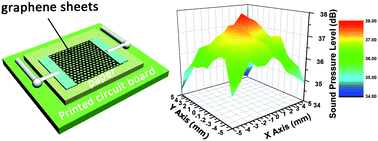Static behavior of a graphene-based sound-emitting device
Abstract
Due to the extremely high thermal conductivity and low heat capacity per unit area of

* Corresponding authors
a
Institute of Microelectronics, Tsinghua University, Beijing 100084, China
E-mail:
RenTL@tsinghua.edu.cn
b Tsinghua National Laboratory for Information Science and Technology (TNList), Tsinghua University, Beijing 10008, China
Due to the extremely high thermal conductivity and low heat capacity per unit area of

 Please wait while we load your content...
Something went wrong. Try again?
Please wait while we load your content...
Something went wrong. Try again?
H. Tian, D. Xie, Y. Yang, T. Ren, Y. Wang, C. Zhou, P. Peng, L. Wang and L. Liu, Nanoscale, 2012, 4, 3345 DOI: 10.1039/C2NR30417A
To request permission to reproduce material from this article, please go to the Copyright Clearance Center request page.
If you are an author contributing to an RSC publication, you do not need to request permission provided correct acknowledgement is given.
If you are the author of this article, you do not need to request permission to reproduce figures and diagrams provided correct acknowledgement is given. If you want to reproduce the whole article in a third-party publication (excluding your thesis/dissertation for which permission is not required) please go to the Copyright Clearance Center request page.
Read more about how to correctly acknowledge RSC content.
 Fetching data from CrossRef.
Fetching data from CrossRef.
This may take some time to load.
Loading related content
